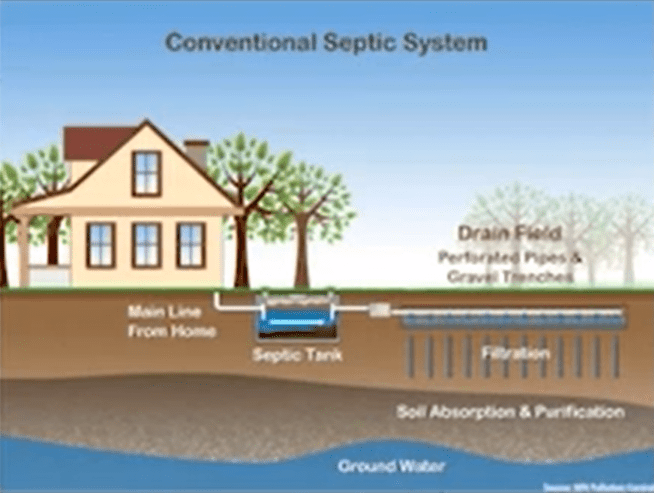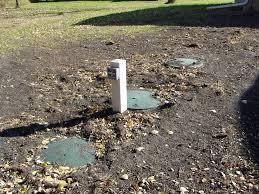Understanding Your Septic System and How It Works
The first step to understanding your septic system is to familiarize yourself with what you have. It is important to know that your system was designed specifically for your home taking into consideration, number of bedrooms (estimate of number of people), soil type and depth to water table or other confining layer. If you don’t already have your septic system drawing, you can contact your county permitting office to request a copy.
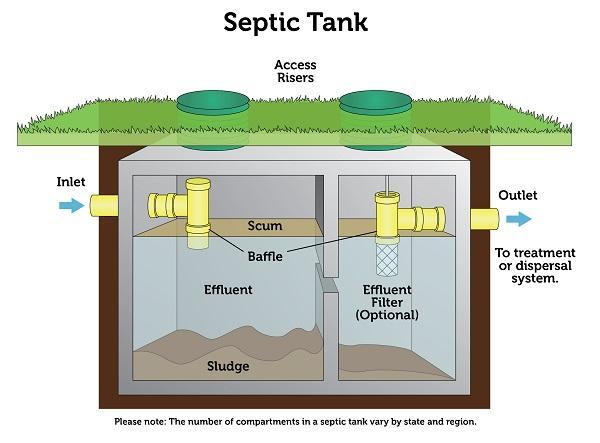
The septic system on your property includes two components: a tank and a soil dispersal area or drainfield. A conventional septic system will include a distribution box to help distribute the wastewater evenly among the trenches to ensure maximum wastewater to soil contact. Household wastewater enters the septic tank through the inlet. As the wastewater sits, fats, oils, grease and soap float to the surface (scum). Solid materials from the wastewater settle to the bottom, where a portion of the the sludge is decomposed by anaerobic bacteria. The baffles in this illustration prevent sludge and scum from escaping and contaminating the rest of your well water system. Filters can be placed in the outlet baffle to provider greater retention of scum and sludge. Newer tanks may have two compartments with a concrete dividing wall, which limits the amount of scum and sludge that can reach the outlet. Newer tanks may also have two manhole covers, one above each baffle. If your manhole cover is buried underground, you should consider having a riser added to your tank so that the manhole cover can be accessed from the ground surface. Having the manhole cover on the ground surface will not only make access easier, it will make it less expensive when a professional works on your tank. After the wastewater is treated in the tank, it will flow to a soil dispersal area or drainfield, where the effluent water is further treated. In a conventional septic system, the majority of treatment occurs in the drainfield.
Drainfield (Trench)
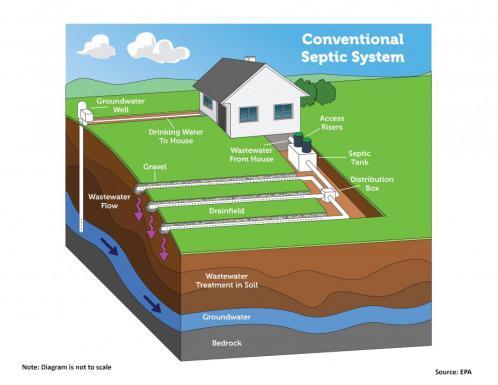
Waste water flows from the tank through a solid pipe into a distribution box, where it is then channeled into perforated pipes set in trenches of gravel. The water slowly seeps into the underlying soil in the drainfield. As the effluent water is released into the ground, natural filtering processes remove disease-causing organisms, organic matter, and most nutrients (except nitrogen and some salts). The purified wastewater then either moves to the ground water or evaporates from the soil.
Sand Mounds
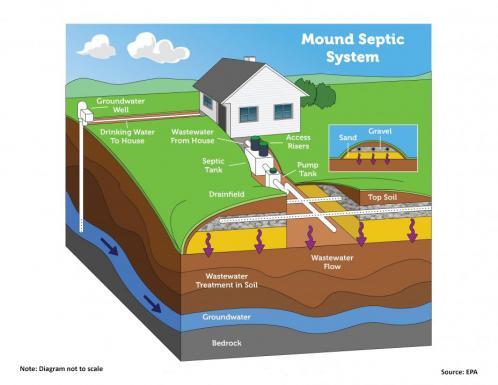
Sand mounds are generally used if the underlying soil has too much clay to allow the water to efficiently seep through, or the water table is too close to the surface. In these systems, waste water flows from the septic tank to a storage tank. Liquid is pumped from the tank to perforated plastic pipes buried in a mound of sand built on the ground surface. This system provides a layer of suitable soil thick enough to ensure adequate time and distance for proper treatment of the waste water. Vegetation growing on the mound helps to evaporate some of the liquid.
Best Available Technology (BAT) Unit

A BAT unit or aerobic treatment unit (ATU) are designed for enhanced nitrogen removal to reduce the amount of nitrogen entering drainfield and surface and ground waters. A BAT unit is a multi-chambered system providing both aerobic (with oxygen) and anaerobic (without oxygen) conditions enabling beneficial bacteria to breakdown the wastes. BAT units can reduce nitrogen by 55 to 80% compared to 5% with a conventional septic tank. The BAT unit only replaces the tank component of a septic system and a soil dispersal area or drainfield is required. For more information on BAT units including costs, efficiencies and operating costs see MDE's Onsite Division website.
It is important to note that a septic system is designed so wastewater will be treated in the tank and drainfield, but that the wastewater ultimately enters the groundwater. Therefore, it is important for both public and environmental health, that your system is maintained properly to reduce risk to drinking water.
